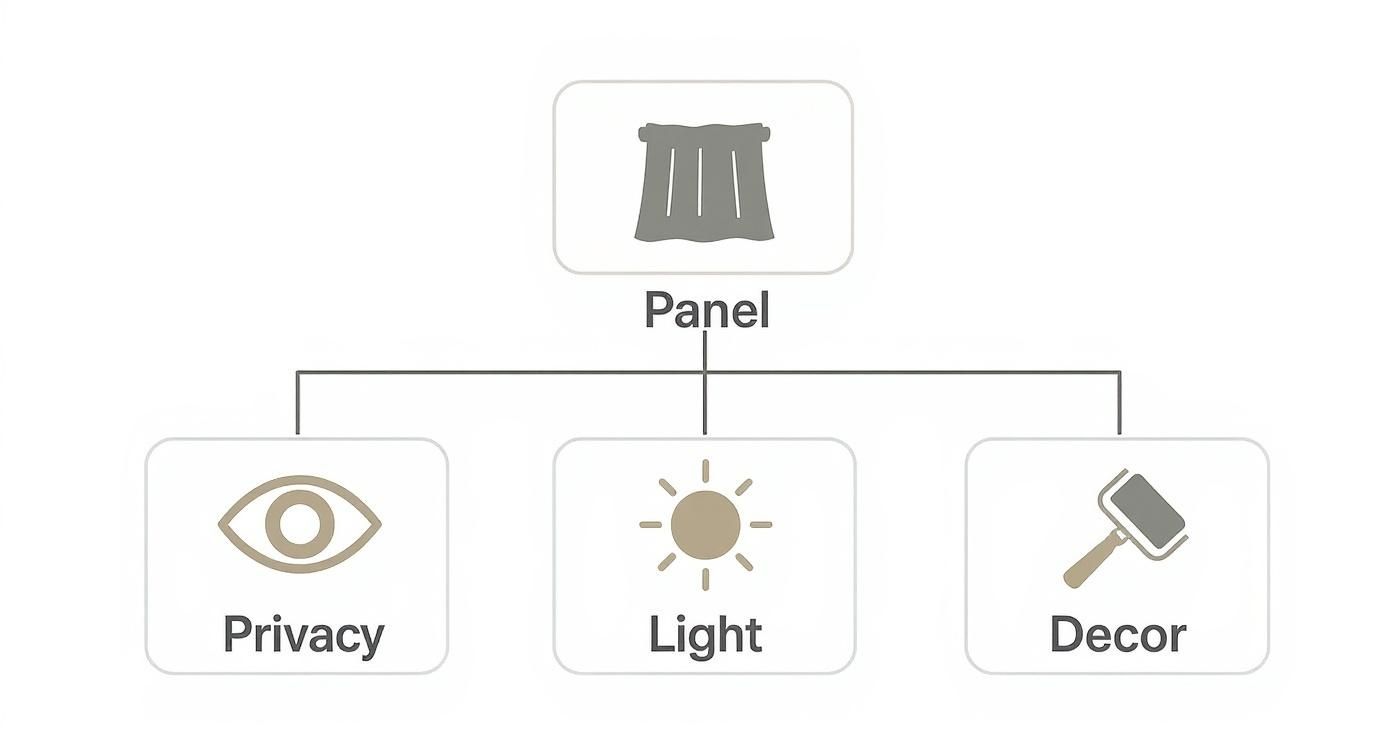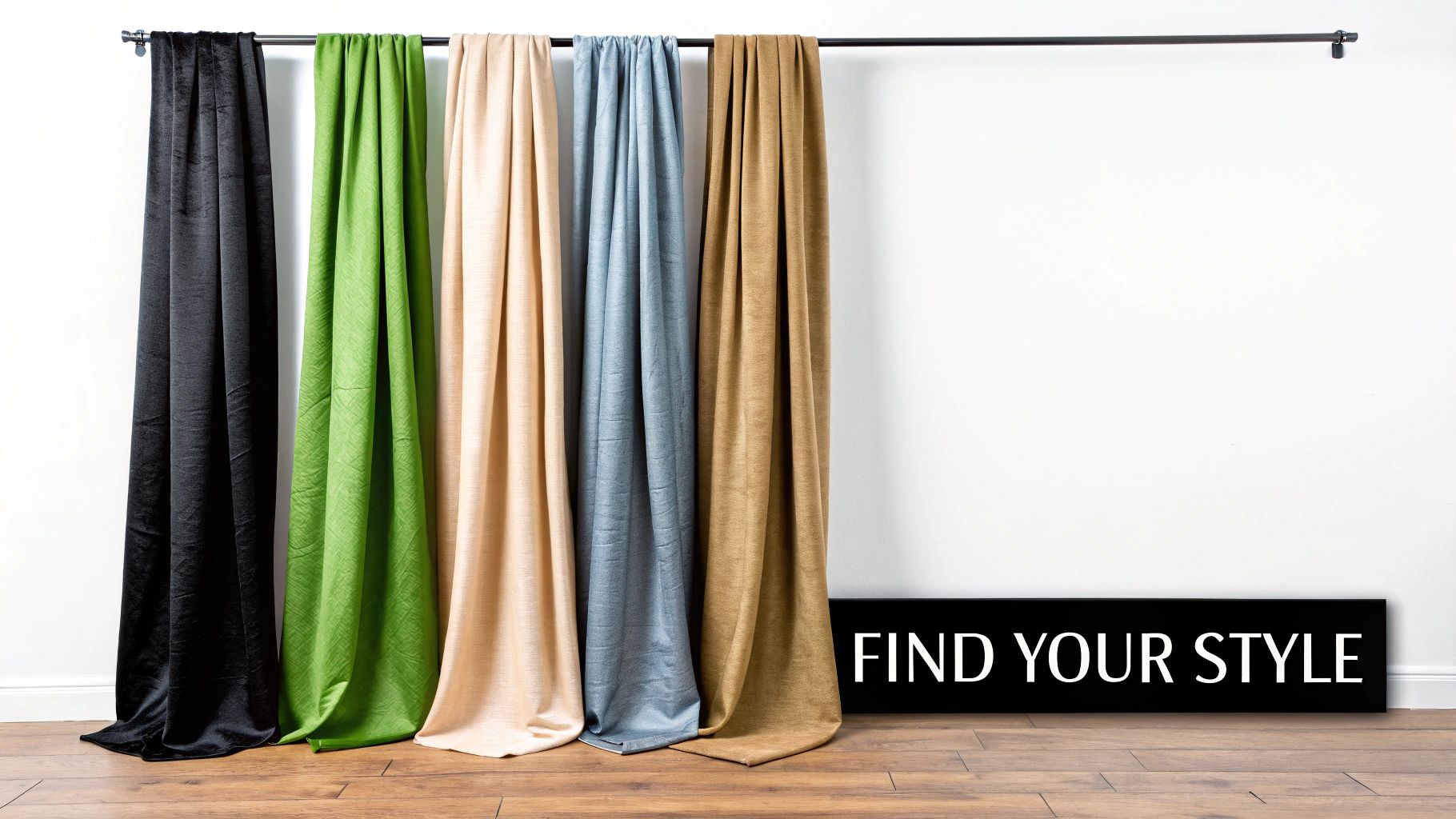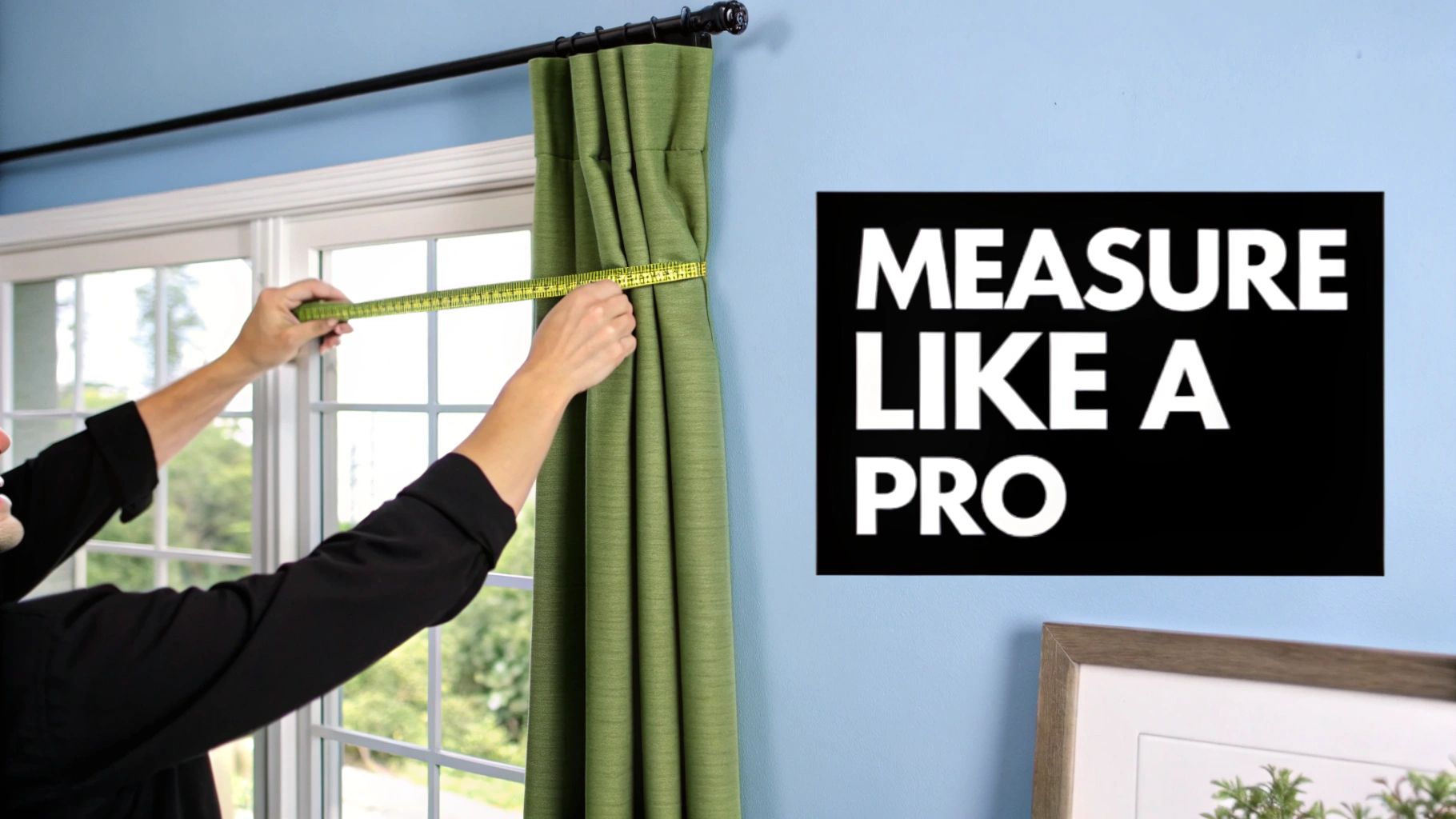
What Is a Drapery Panel? The Ultimate Guide to Choosing Window Treatments
When you hear the term "drapery panel," what comes to mind? To put it simply, a drapery panel is a single, finished piece of fabric designed to dress a window. It’s the essential building block of window design, sold individually to give you complete creative control over your space.
Think of it as a versatile design tool. You can use one panel for a clean, modern statement or pair them up to create the classic, full look that completely transforms a room's atmosphere. This guide will walk you through everything you need to know about this popular window treatment.
Table of Contents
- Decoding the Drapery Panel: More Than Just Fabric
- The Anatomy of a Drapery Panel
- Finding Your Perfect Drapery Style and Fabric
- Drapery Panels vs. Curtains: What Is the Real Difference?
- How to Choose and Measure Drapery Panels Like a Pro
- Frequently Asked Questions
Decoding the Drapery Panel: More Than Just Fabric
So, what really sets a drapery panel apart from a standard curtain? Unlike curtains, which are almost always sold in pairs, a drapery panel’s solo nature is its superpower. This opens up a world of styling possibilities, like using a single panel to frame a narrow window or doubling them up for traditional, full coverage.
But a drapery panel is much more than just a decorative accent. It’s a functional workhorse that serves several key purposes in your home.
- Privacy Control: It acts as a physical barrier, shielding your home from the outside world and giving you that much-needed peace of mind.
- Light Management: Depending on the fabric, it can soften harsh sunlight into a gentle glow or block it out completely for the perfect movie night.
- Decorative Impact: The right color, pattern, or texture can tie a room together, add a pop of personality, or introduce a touch of luxury.
Drapery Panel at a Glance
To make it even clearer, let's break down the key characteristics of a drapery panel.
| Characteristic | Description |
|---|---|
| Unit | Sold as a single, individual panel. |
| Material | Typically made from heavier, often lined fabrics. |
| Length | Usually long, often reaching or puddling on the floor. |
| Styling | Highly versatile for both single and paired applications. |
| Function | Offers privacy, light control, and strong decorative appeal. |
This quick summary shows just how adaptable a drapery panel can be. They are among the most sought-after window treatments in North America, a region that drives over 38% of the revenue in the global curtains market. Considering that market was valued at over USD 10.4 billion, it’s clear that drapes are a significant part of modern home decor. You can explore more data on the global curtains market to see the full scope.
The Anatomy of a Drapery Panel
To truly understand what a drapery panel is, it helps to look at its basic anatomy. A panel consists of three main parts: the header, the body, and the hem. Each one has a specific job, influencing both how the panel hangs and how it functions.
The Header, Body, and Hem
The header is the very top of the panel, and it's what determines how the panel hangs from the rod. This is where different styles can create wildly different effects, from sleek and modern to formal and traditional.
- Grommet Tops: A fantastic, modern choice with large metal rings that create beautiful, uniform folds. They glide smoothly along the rod, making them perfect for drapes you open and close often. Learn more about incorporating grommet window curtain panels in your home.
- Rod Pockets: This is a classic look where a channel is sewn into the fabric for the rod to slide through. It creates a soft, gathered appearance that feels traditional and works best for panels you don't plan to move much.
- Pleats: For a more formal, tailored vibe, you can't go wrong with pleats. Elegant, structured folds like pinch pleats or box pleats are sewn right into the header, adding a real touch of sophistication.
Next up is the body, which is the main stretch of fabric. Its secret weapon is the lining. An unlined panel offers a light, airy feeling, but adding a lining introduces serious functionality. You can have sheer linings to gently diffuse light or go for thermal and blackout linings for insulation and total darkness.
This infographic breaks down the main jobs a drapery panel's body handles.

Finally, we have the hem—the bottom edge of the drapery panel. A high-quality panel will almost always have a weighted hem, with small weights sewn into the bottom corners. This crucial detail ensures the panel hangs perfectly straight and drapes flawlessly.
Finding Your Perfect Drapery Style and Fabric

Choosing a drapery panel is like picking the right outfit for a room. It needs to fit the mood, serve a purpose, and show off your personality. The fabric you choose is the single most important part of that decision, setting the stage for everything from light control to the overall atmosphere.
Matching Fabric to Your Room's Vibe
The link between a fabric and its function is direct. Ask yourself what you need from the room. Is it a bedroom where you need total darkness to sleep, or a formal dining room that could use a touch of elegance?
Here's a quick rundown of popular fabric choices:
- Linen: Your go-to for a light, breezy, and relaxed feel. Its natural texture is perfect for coastal, minimalist, or modern farmhouse styles.
- Velvet: Nothing says luxury like velvet. Its heavy weight is fantastic for blocking light and dampening sound, adding a rich, opulent vibe to formal rooms.
- Silk: For a timeless, romantic elegance, silk is a beautiful choice. It drapes gorgeously but is delicate, so it's best for formal spaces without tons of direct sun.
- Polyester Blends: The practical workhorse of drapery. They're durable, easy to clean, and resist wrinkling and fading, making them a smart pick for sunny rooms.
If you want to dive deeper into how different textiles behave, understanding different upholstery materials offers great insights into durability and texture.
Making the Right Material Choice
When picking a fabric, think beyond looks and consider the practical side. Are you prioritizing privacy, light control, or a decorative touch? Our guide on exploring different curtain cloth types can give you an even more detailed look at your options.
To make it easier, here’s a simple breakdown of how these common fabrics stack up.
Common Drapery Fabric Comparison
| Fabric | Best For | Pros | Cons |
|---|---|---|---|
| Linen | Casual, airy spaces like living rooms or sunrooms. | Lightweight, breathable, beautiful natural texture. | Wrinkles easily, can be sheer. |
| Velvet | Formal living rooms, bedrooms, home theaters. | Excellent light and sound blocking, luxurious feel. | Heavy, can attract dust, requires special cleaning. |
| Silk | Elegant, formal spaces like dining rooms. | Drapes beautifully, has a subtle, elegant sheen. | Fades in direct sunlight, delicate, harder to clean. |
| Polyester | High-traffic areas, kids' rooms, sunny windows. | Durable, fade-resistant, easy to clean, affordable. | Can sometimes look less luxurious than natural fibers. |
The global market for window treatments is massive. Worldwide revenue for curtains and blinds is projected to hit US$38.92 billion, with the U.S. market alone expected to reach USD 5.44 billion. Discover more insights on the curtains and blinds market size.
This trend shows how much homeowners value finding that perfect style. Your choice between a breezy linen and a sumptuous velvet isn't just a detail—it's a defining feature that brings your room's vision to life.
Drapery Panels vs. Curtains: What Is the Real Difference?
It’s one of the most common mix-ups in home decor, but the difference between drapery panels and curtains is refreshingly simple. The short answer is that it all comes down to fabric weight and construction.
Think of it like a tailored wool coat versus a light spring jacket. A drapery panel is the heavyweight champion. These are crafted from substantial fabrics like velvet or heavy linen and are almost always lined. This layered construction gives them a structured, formal drape and makes them powerhouses for blocking light and insulating a room.
Curtains, on the other hand, are the lightweights. They're usually unlined and made from casual fabrics like cotton or sheer voile. Their main job is to gently filter light and add a soft, decorative touch.
Key Distinctions at a Glance
Let's break down the core differences to make your next window treatment decision a breeze.
- Fabric Weight: Drapery panels use heavy, thick materials for a formal hang. Curtains use light, often sheer fabrics for an airy feel.
- Lining: Drapes are almost always lined, often with blackout or thermal layers. Curtains are typically unlined.
- Light Control: Drapery is engineered to block light effectively. Curtains are made to filter it softly.
- Formality: The structured look of drapery lends itself to formal spaces like dining rooms. The casual nature of curtains is perfect for kitchens and living areas.
To see these differences in action, you can explore various curtain styles and compare them to more substantial drapery options. Ultimately, understanding the difference is all about choosing the right tool for the job.
How to Choose and Measure Drapery Panels Like a Pro

Choosing the right drapery panel is about more than just picking a pretty fabric. To get that polished, professional look, you need to start with precise measurements and a clear idea of what you want the drapes to do for the room.
Step 1: Master the Measurements
Before you dream about colors, grab a measuring tape. Getting this right is the foundation of a beautiful window treatment.
- Measure Width: Measure the width of your window frame. Now, add 6 to 10 inches to each side. This extra space allows the panels to hang beautifully beside the window when open, letting in maximum light and making the window appear larger.
- Measure Height: Decide where to place the curtain rod—we recommend 4 to 6 inches above the window frame. Measure from that point down to where you want the panels to end. This is your target length.
For more guidance, our comprehensive guide to measuring windows for drapes walks you through every detail to help you get that perfect, custom-fit look.
Step 2: Match Function to the Room
With measurements in hand, think about what the drapery panel needs to accomplish. Is this for a sunny living room where you want filtered light, or a bedroom that needs to be a dark sanctuary?
A simple rule for drapery length is the “kiss, float, or puddle” method. A panel can “kiss” the floor for a tailored look, “float” just above it for a crisp feel, or “puddle” onto it for a romantic, dramatic effect.
For instance, sheer panels are perfect for living areas where you want to gently filter sunlight. On the other hand, blackout panels are a must-have for bedrooms, offering the complete darkness essential for restful sleep.
The desire for functional and stylish home decor is a worldwide trend. The Asia-Pacific market, for example, is expected to see the fastest growth in window treatments, with a CAGR of 4.1%, as more people look for products that blend practicality with beautiful design. You can read the full research on the global curtains market to learn more.
Frequently Asked Questions
Can you use just one drapery panel?
How do I clean my drapery panels?
- Machine Washable: Sturdy fabrics like polyester or cotton blends can often be washed on a gentle cycle with cold water.
- Dry Clean Only: Delicate materials like silk or velvet, and any panels with special linings (like thermal or blackout), almost always need professional dry cleaning to prevent shrinking or damage.
What is the best header style for drapery panels?
How high above the window should I hang my drapery rod?
At Joey'z Shopping, we believe that the right window treatments can completely transform a room. Explore our collection of high-quality drapery panels and find the perfect style to bring your vision to life. Visit us at https://joeyzshopping.com to get started.
